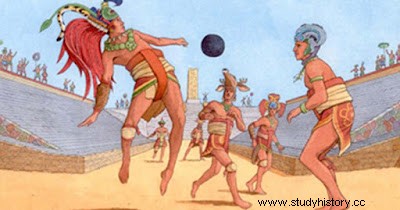 Mesoamerican ballgame later known as
Mesoamerican ballgame later known as 'Ulama' in which they are used currently the “ball-hip” rules The first ballplayer panels in Belizean history The first panels ever found in the history of Belize showing Mayans playing ball. In the first panel, a ball player can be seen, recognizable by his posture and his protective belt. He is playing with a large round ball, while in his left hand he holds a complex fan. Experts assume that it would measure around 1.5 meters wide and 70 centimeters high in its initial form, but almost ten percent of the image has been lost over the centuries. In addition, archaeologists suggest that the panel was intentionally vandalized at some point, with one of the figures in particular being extremely scratched.
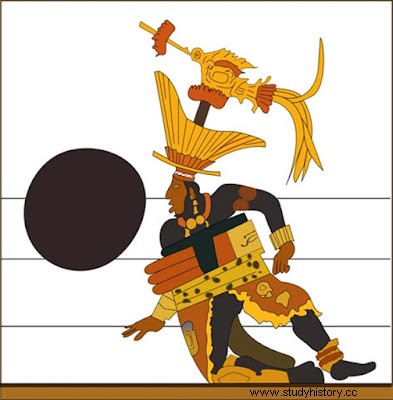 Sak Ch'een, lord of Motul de San José c. 8th century, dressed as a ballplayer
Sak Ch'een, lord of Motul de San José c. 8th century, dressed as a ballplayer The panel bears an inscription that reads "nine span balls", which indicates the size of the ball's circumference. Elsewhere on the panel you can read the player's surprising name, “Water Roll Ocelot”. The second panel is somewhat smaller, but it also shows a human figure participating in a ball game. Unfortunately, the face of this figure has also been scratched.
The enormous importance of the Ball Game in ancient Mesoamerican cultures Ball games were very important from a social and political point of view for the Maya, as the authors of a study published in the journal Antiquity mention, "The iconographic and glyphic analysis of these panels within a regional context provides new data on large-scale sociopolitical relations, demonstrating that the ballgame was an important means and mechanism of macropolitical affiliation in the Maya lowlands,” write the authors, led by Christopher Andrés of Michigan State University.
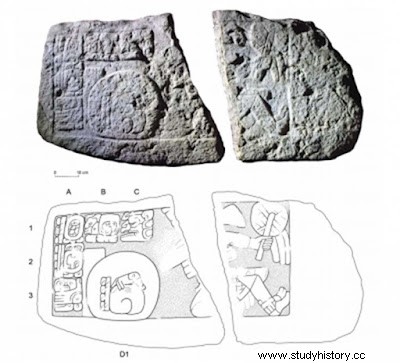 On the right side of the panel a ballplayer can be seen carrying a fan
On the right side of the panel a ballplayer can be seen carrying a fan The Ulama, without a doubt the most famous ball game in Mesoamerican history, was not simply a game for the Olmec, Mayan and Aztec civilizations, it was much more than that. As Ancient Origins previously reported, the Ulama was considered a battle waged by the sun against the moon and stars, representing the principles of light and dark (and possibly also the battle between good and evil). In addition, the movements of the ball symbolized the rotation of the sun for the Aztec, Olmec and Mayan peoples. To the Mayans the game was known as Pok a Tok, the Aztecs called it Tlachtli, and nowadays most people refer to it as Ulama. It is believed to have spread as far south as Paraguay, and as far north as what is now Arizona. The oldest known Mesoamerican ball court is that of Paso de la Amada, in Mexico, dated by radiocarbon to an antiquity of around 3,600 years.
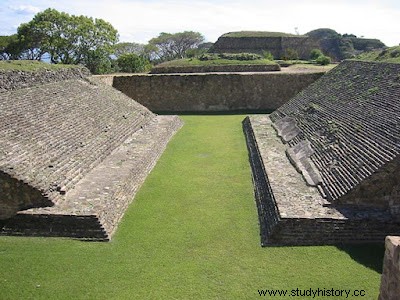 Mesoamerican ball game court in Monte Albán (Mexico)
Mesoamerican ball game court in Monte Albán (Mexico) To date, almost 1,300 Mesoamerican ball courts have been discovered, and it is estimated that all ancient Mesoamerican cities had at least one. Olmec courts were the size of a modern soccer field, and when viewed from the sky they looked like a capital “I” with two perpendicular end zones at the ends. The courts were delimited by stone blocks, and it was played in a rectangular enclosure with sloping walls. These walls were often clad and painted in bright colors. Snakes, jaguars and carved stone eagles were represented along with images of human sacrifices, in a fact that suggests a connection with the divinity.
Everyone played ball regardless of their social status The new study focuses on the fact that these ball games were not just played by ordinary people, but by individuals from all kinds of socioeconomic backgrounds. Nobles and local leaders have been portrayed playing on various occasions, while important foreign figures also appear in images and works of art from that time.
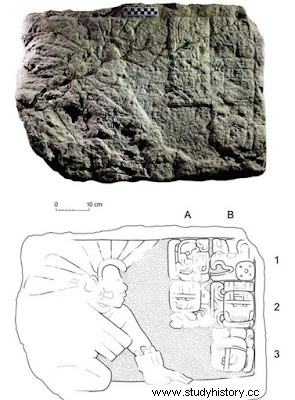 Smaller panels showing a human figure playing ball
Smaller panels showing a human figure playing ball “These ballplayer panels may reflect a larger system of loyalties cemented in part by public performances involving landowners and lords at the ballgame,” the study authors write as reported by IBT. The researchers are optimistic that by re-examining these panels, more information about the sociopolitical makeup of the ancient Mayan civilization may be uncovered.
Author:Theodoros Karasavvas
